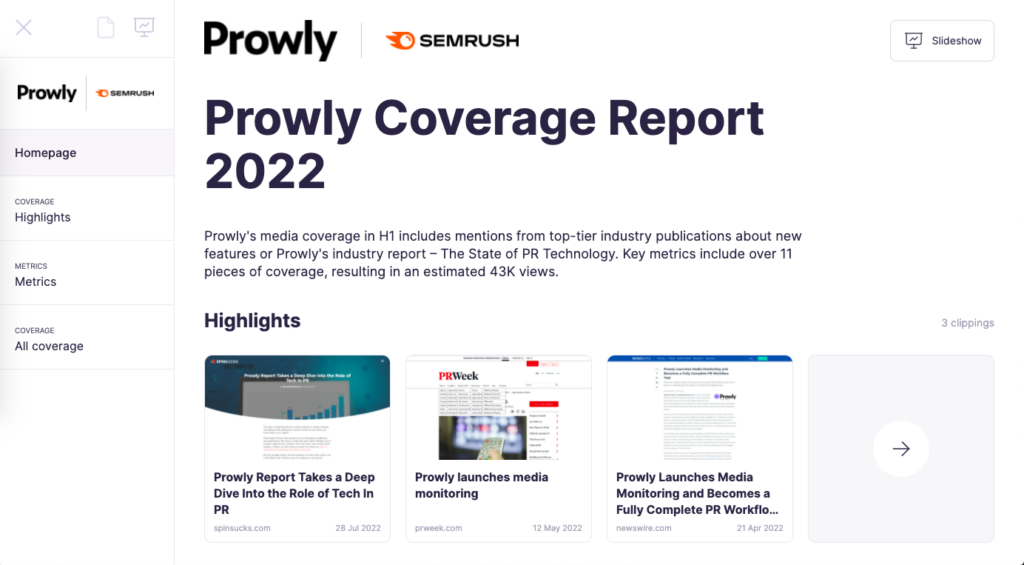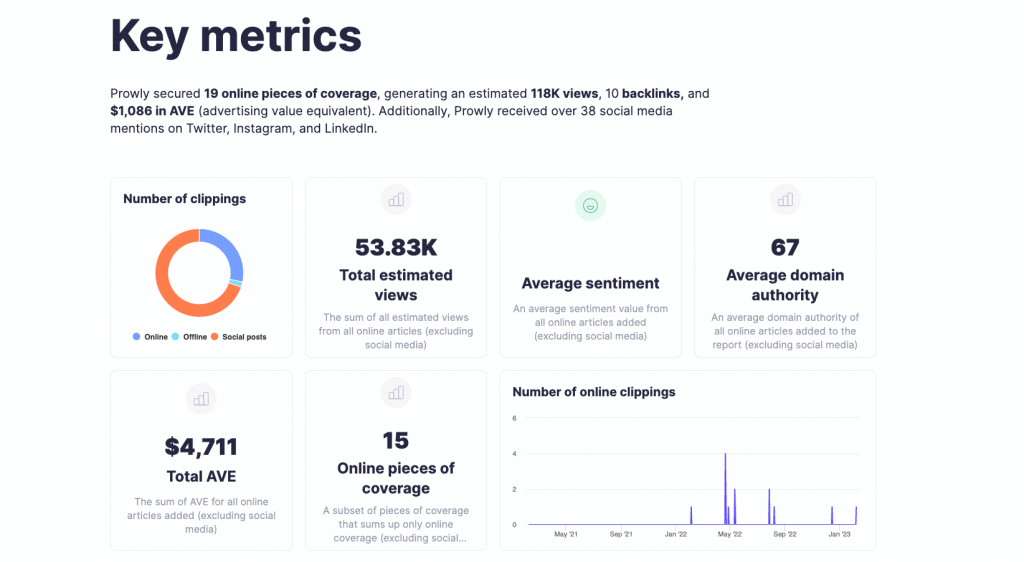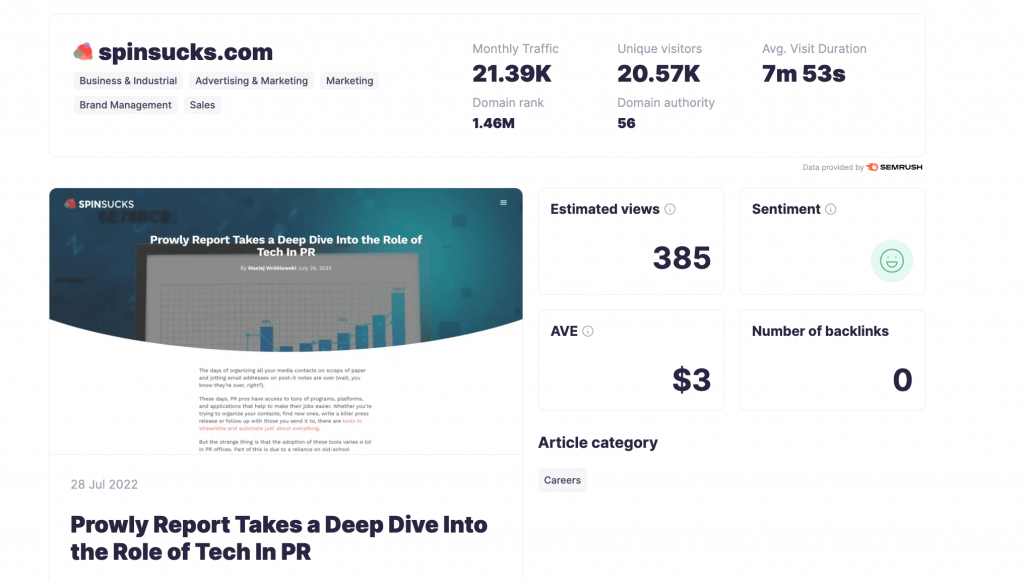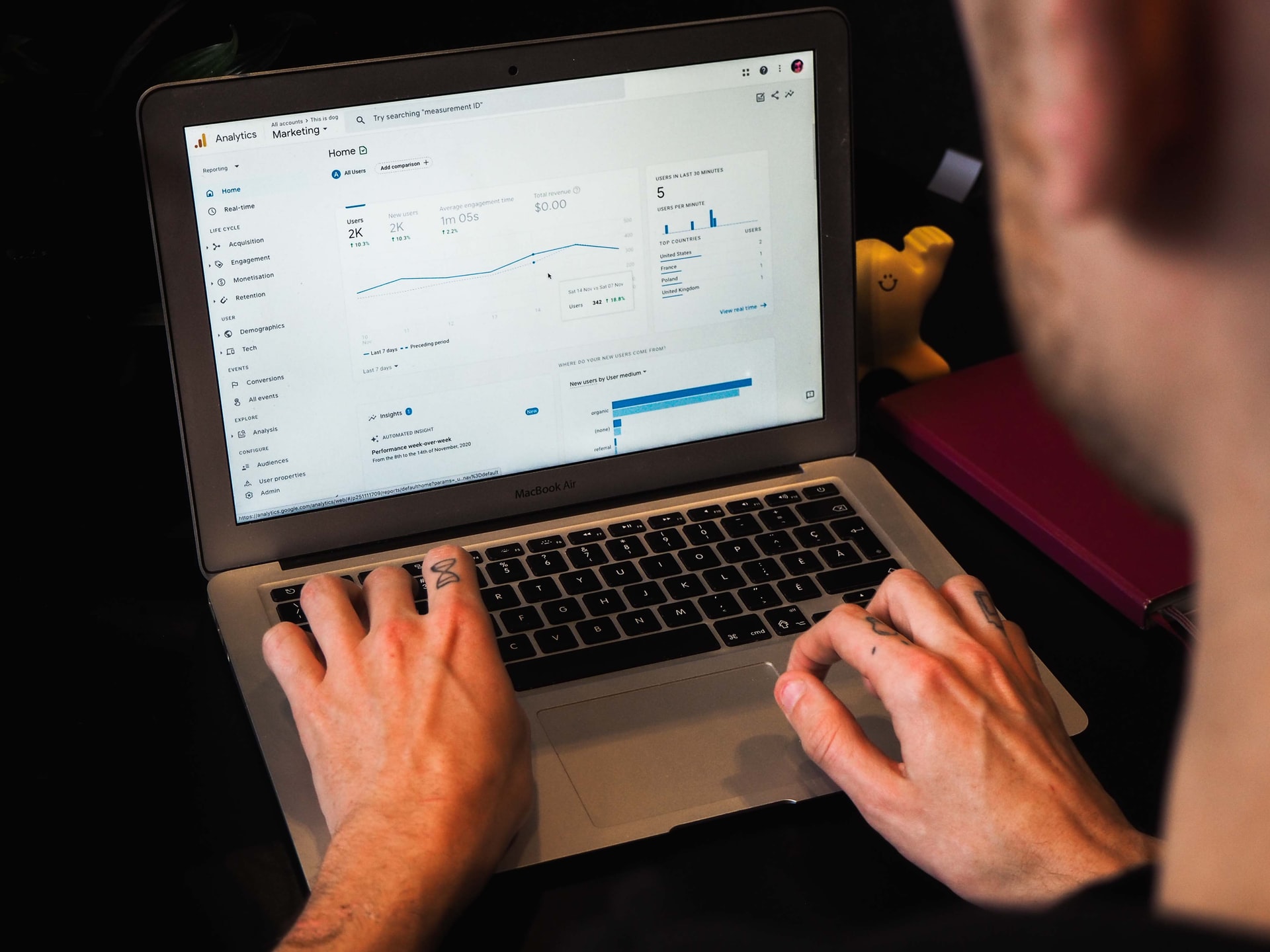It’s the end of the month, and you’re staring at your screen, sighing. Client PR campaign reports are due again. Didn’t you just do this?
Sure, you love the thrill of brainstorming strategies, writing releases, and pitching stories, but when it comes to reports, the excitement fades. Scrolling through mentions, resizing images, and creating professional reports manually? Not exactly your idea of fun.
And don’t even get started on collecting metrics and putting it all together in a neat, presentable way. If you’re still doing this with Word docs, we feel you.
The real question is - there’s gotta be a better way, right? If you’ve been hunting for a PR campaign report template that makes your life easier, you’re in the right place. Ready to ditch the hassle? Prowly offers a 7-day free trial to help you create reports without the headache.
Try Prowly's media monitoring free for 7 days
Create media reports and start tracking your brand for free in Prowly.
- Comprehensive Monitoring: Track the web and social media mentions.
- Transparent Pricing: Plans start at $258/month
- All-in-one platform: Get everything you need in one tool for PR, incl. media database, outreach, reporting, and more
The Importance: PR Reports Retain Clients
Let’s take a step back and acknowledge why a PR report (also referred to as a PR coverage report, press clippings report, or media coverage report, to name a few) is so important for your business.
You can’t show your clients the work you do for them every day. They have to trust your process, and you need uninterrupted time to strategize, write, and pitch.
So, PR reports are how you effectively summarize all the hard work you’ve done for the past period. It’s through the results that you show your clients the value of your daily, consistent PR efforts.
It’s how your clients come to write the check each month for your agency’s PR retainer, knowing that with more investment comes more great work.
So, Where to Begin?
The best PR campaign report examples you’ll come across have one major feature in common: they have impact because they’re concise.
It may feel counterintuitive to keep a PR report brief, but it’s important that you don’t overwhelm the client with too much data. (Yes, we’re giving you permission to resist the urge to add yet another page or graph).
Why? It’s because your client is busy like you, and their time is very limited. If there is too much information to read and process, you will lose their attention quickly. They may even close your report and plan to come back to it later, only to have it get buried in their email inbox. What a lost opportunity to show your great work!
This is where you need to focus on providing a few key data points that stand out from all the rest. Make sure each point is specific and touches back on the most important question your client may ask: why does this coverage matter?
PR Campaign Report Example
A stellar PR campaign report is going to quickly pique the interest of your client. It’s going to include the coverage you placed for the period in a visually exciting way.
We've created a sample PR report created using Prowly to give an idea of what should be included.
Main page
The main page of your report should give an overview of the most important pieces of coverage and mention key metrics such as estimated views.
It's crucial to make sure the page isn't overwhelmed with too much information and lets anyone quickly understand an overview of the coverage achieved.

Coverage highlights
If you were successful with your campaign or are preparing a yearly coverage report, you'll most likely have a lot of mentions.
Because of this, it's a good idea to include a highlight page where you can quickly present the most important pieces of coverage that you're proud to show off.

Metrics page
Be sure to include a page where viewers easily see all the key metrics that were achieved, such as the number of press hits, total estimated views, average domain authority, total AVE, or the number of backlinks generated.
You can add a description to help readers understand what these metrics mean, or what's considered a good result.

It's also worth including metrics for every mention or at least the most important ones to asses the value of each particular press hit by adding your own tags you will highlight and categorize the mentions.

All coverage
Don't forget to include a page with all the relevant clippings you were able to find, including niche or less popular publications and social media. Here's also the Practical Guide to PR Clippings for your PR agency if you'd like to delve a bit deeper into the topic.

Try it yourself for free
You can set up a free 7-day trial with Prowly and build your own PR reports, find media contacts, create press releases, and more.
A PR Campaign Report Template
If you plan to DIY your PR reports, Word or Excel are popular options, though not as flexible as you might like. Some PR pros prefer a more design-centric template, so they use PowerPoint or Canva.
No matter the format you use, here’s a template of what you should include.
A brief summary of the period’s work
Reiterate the main PR campaign goal and point to how the month’s work has moved you closer to achieving it. For example, a PR campaign goal of brand awareness would lead you to immediately share an increase in positive consumer sentiment for the month. The closer you can align your PR work with resulting sales or brand awareness, the better.
All coverage for the month
Include a hyperlink to each article, blog post, social mention, or video. Make it very easy for the client to jump over to the resulting coverage for a closer look. Include screenshots of the coverage to make the PR campaign report visually pleasing.
The key metrics by media
For each media mention, include the valuable metrics for the media outlet, like its estimated monthly reach.
Estimated media placement value
In PR, we do our best to provide an estimated value to each media mention. Agencies prefer to use different measurements, so choose the one that’s the best fit for you. Some of the measurements options are:
- Resulting increases in your client’s website traffic.
- Any positive changes tracked through your media monitoring tools, including Share of Voice (SOV) increases, customer sentiment analysis, and social media engagement.
- The AVE measurement, where you compare the article value to the cost of an ad in the same media outlet.
Other work
You can include a list of any other PR work you’ve completed for the month, including new press releases, an updated online press room, analyst briefings, or white papers.
Next steps
To leave your client in ultimate ease, let them know you already have a plan for next month. Briefly mention your next steps for the weeks ahead.
PR Reports Google Sheets Template
Although we recommend using a more design-friendly tool like Prowly, here are two templates if you are using Google Sheets.
The PR Reports Dream: Full-Circle PR Automation Software
We’ve provided you with a template for what to include, but we should also mention the next step for your business that would make these regular PR reports so much easier.
Busy PR professionals thrive with an automated PR software that includes a reporting feature.
For example, Prowly’s PR automation software covers the entire PR workflow process. It includes everything from researching journalists and creating media contact lists to crafting press releases. You can also build there an online media newsrooms, and handling media monitoring and PR coverage report creation.
It’s feature is called PR Reports, and it's a reporting module that comes in Basic and Advanced options based on an agency’s needs.
PR automation software that includes reporting
Here is what happens in a few clicks:
- You use a reports builder instead of writing the report from scratch.
- You can create different pages for your summary points and coverage.
- You cut and paste coverage links and watch the system automatically pull in online clippings with visuals.
- You get to choose which metrics to include, such as total estimated views, average sentiment, and average domain authority. Other options are total AVE, total number of backlinks, and social posts by channel.
- Add any metrics you need, like number of webinar attendees, budget spent, expert comments placed.
- Visualise data using various charts and compare them with previous reports.
- Then, the system automatically pulls those metrics into your report!
Conclusion
Once you’re done, you can publish and deliver these reports online! Simply send a link to the password-protected report. The reports are responsive and can be read on a desktop, tablet or mobile device. You can even set the report to presentation mode if you plan to review the report with your client in a meeting.
Your client can click on online mentions and view them directly, including videos played right from the report.
Much better than starting from scratch with a blank Word doc each month, right?
Sounds a lot better than building a PR report from the ground up each month, right?
We thought so!
If you want to give it a try, Prowly offers a free trial so you can see the benefits in action. Our research shows it’s a more affordable PR software solution when compared to other big competitors like Cision and Meltwater. Plus, you’ll have your full PR process automated, versus only getting reporting from companies like Releasd and CoverageBook.
Here’s to making the PR reports process a whole lot easier. No more end-of-month dread!

